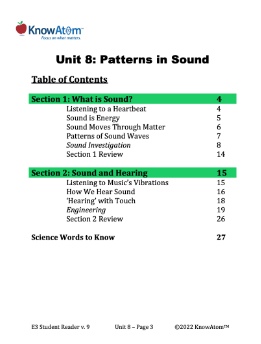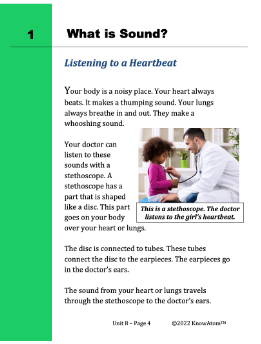This science background provides teachers with more detailed information about the phenomena students explore in this unit - in this case, sound energy and mediums. Below is an excerpt from the science background section.
Evelyn Glennie has said that hearing is a specialized form of touch. This is because sound is energy that is carried in waves of vibrating molecules. To vibrate means to move back and forth quickly.
As forces transfer energy through a system, they disturb molecules at rest, causing them to vibrate. Think of your heart beating. When your heart beats, it makes the molecules of matter around it vibrate and bump into the molecules closest to them. This passes on the energy and makes them vibrate too. Then those molecules bump into more particles, and so on. The vibrations travel out in all directions. Molecules stop vibrating once they have passed on the energy.
Patterns of vibrating molecules as sound moves through a medium are called sound waves. A medium is matter that a wave travels through, and it can be a solid, liquid, or gas. Your body has all three. For example, water and blood are two liquids found in the human body. Tissues and bone are solid, while oxygen and carbon dioxide are gasses.
Sound travels faster through a solid than it does through a liquid or a gas. This is because of how the molecules in each are arranged. Sound can move from molecule to molecule much faster in a solid because the molecules collide with each other more frequently. Sound energy cannot move as quickly when the molecules are farther apart or not in contact with each other. Solids, liquids, and gasses are all mediums because they are matter that waves travel through.
As sound energy moves through matter, it causes molecules to press together. This is called compression. When this happens, the molecules on either side of the compression spread out. This is called rarefaction. The distance from one compression to the next or from one rarefaction to the next is the wavelength. A wavelength is the distance spanned by one cycle of the motion of a wave.
How compressed the molecules become as the sound wave moves through a medium determines the wave’s amplitude. Amplitude is a measure of the wave’s displacement from its resting position. Displacement refers to the movement of a substance from its resting position. A sound wave’s amplitude is the amount of compression that occurs as it moves through the medium. In sound waves, the amplitude of a wave also determines the sound’s volume, which is how loud or soft a sound seems.
The frequency of a wave is the number of waves that pass a set point in a given amount of time. Frequency is closely related to pitch, which describes how high or low a sound is when you hear it. A wave with a higher frequency has a higher pitch than a wave with a lower frequency.
If someone is within the range of the sound waves, they will hear sound. Hearing is the brain’s interpretation of information carried by sound waves.










